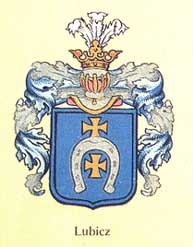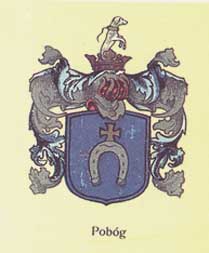

***PLEASE NOTE: We are presently working on the recovery of the patent given to Tomasz Adam Dabrowski by the Russian Czar. This document was lost. However, since it was REQUIRED for nobles to buy land, it should be on record somewhere.
*=Clans associated with the horseshoe as their symbol.
(1)Abdank ... Abdank

(2)*Dabrowa [with 3 crosses or (gold)]. One cross patee (Formee) and two crosses pat$#233;e fitched (or sharpened to a point). The cross is a symbol of Christianity. This arms features azure (blue) and argent (white) mantling, with a crest coronet. The azure (blue shield). Azure is from the Arabic "lazura." ...
The author of the first history of Prussian Poland asserts in his manuscripts that the first ancestor of the Dabrowa clan was a foreign knight. This knight participated in the Crusade begun by Pope Urban II. Christian armies were called (in 1096), to recover Jerusalem, and with it the grave of Christ, from the Turks. The Christian army would be composed of both knights and peasants.
Godfrey of Boullion, France, would lead one of the armies to the Holy Lands, as would his two brothers. Godfrey sent a courier to King Boleslaw Krzywousty (meaning "Wry" or Crooked Mouth") (1086-1138), of Poland, to ask for free passage through his kingdom to Novogrod. From Novogrod, they would travel south on the Volga River to the Sea of Azo and the Black Sea.
Boleslaw and his brother, Zbigniew, shared Poland after the death of their father, Wladyslaw Herman (1042-1102). Zbigniew and Boleslaw quarreled and in 1112, Boleslaw had his brother blinded and thrown into the dungeon, where he died soon afterwards.
Offering passage through Poland was a test of faith, since the Crusaders often took things when they were hungry. For example, at the Hungarian border, the Crusaders were stopped and they remained there for three days in the month of September. The Hungarian king was not happy to see the Crusaders crossing his country. To show his army's intentions were honorable, Duke Godfrey de Bouillon left his brother Baldwin, together with his wife and children as proof that he would not cause harm to the Hungarian people. The Poles and Hungarians rarely involved themselves in the Crusades. Godfrey's family was returned after they got to the river Drave, at the Bulgarian border. Again they were met at the border, this time by Emperor Alexius and his Greek forces. They all marched to Philippolis, where they were provided with an abundance of food and wine. From Philippolis they crossed the sea and went to the city of Nicaea (at that time possessed by the Turks). The Turks had subjugated the whole land of Roum as far as the city of Nicomedia. The Crusaders massed together and Nicaea fell on the Summer Soltice on June 19, 1097.
True contingents set out from northern France, They took roads through southern and eastern Germany, into Hungary and Bulgaria, and entered the territory of the Byzantium Empire. Many Germans attached themselves to the army as it passed. Spectators became soldiers as they were caught up in the zeal and extraordinary pageantry which the army displayed, as the group marched under the sign of the cross, and in the name of Christ (Foss, 72).
When this early ancestor of the Clan Dabrowa distinguished himself by his courage at Jerusalem, Godfrey de Bouillon, was King of Jerusalem. This gallant foreign knight had bestowed on him, via Godfrey Bouillon, a new coat of arms. The coat of arms was a rendition of Calvary Hill (Golgotha). Golgotha was the hill upon which Our Lord Jesus Christ's was crucified with two thieves. The new arms would bear three crosses patée, in the center; and one cross patée fitched on each side of the middle cross. These crosses were called "Dabrowa," in Polish.
After this knight returned from Palestine, he took the same path through Poland. He was fond of the scenery so he settled in Poland and his descendants still exist there today (The History of Prussian Poland by Posselii, stored in the Collection of Premisl. S. I, folio 56.)
To check the validity of this story we must examine this facts:
These three brothers went from France to the Holy Lands, and led the First Crusade. Baldwin and Godfrey were both great lords of northern France. Godfrey's castle was located in Bouillon. Duke Godfrey was elected King of Jerusalem in 1100, only eight days after the city of Jerusalem was taken from the Turks, on July 15, 1099. Jerusalam was the location of Mount Sion. Many events from the New Testament (in The Holy Bible), happened in Jerusalem. Jerusalem was a Holy Place to all Christians.
However, the offer of kingship was first given to Count Raymond of St. Gilles. Raymond rejected the idea saying basically: "Jesus was not a king, nor will I be King of Jerusalem." Godfrey was said to have the fewest enemies of those men that remained, thus he was elected without question. He took the title of Advocatus Sancti Sepulchin ("Guardian and Defender of the Holy Sepulchre"). Godfrey feasted with an Amir in Caesarea, and by the time he reached Jaffa, he was ill and many thought he had been poisoned. Modern historians think the illness was most likely typhus, which was widespread, at this time. Godfrey died July 18, 1100.
Godfrey was only king from July 15, 1099 until July 18, 1100 (one year). Thus the grant of the Dabrowa arms had to be between these dates, thus making this arms one of the oldest arms of those the Dabrowski family would receive.
Dabrowa - Dabrowski was again established in Bialy, Lithuania, in 1450, and Wizna in 1519. Another noble Dabrowski was established in the Dabrowa clan in Wizna in 1444, and Nadia Larson's great-grandfather had a patent signed by the Czar saying he was noble. Thisa document was necessary when buying land, under Russian rule.

(3)*Dol`ega (with cross/arrow) ...this coat-of-arms appears in 1345, as the seal of Mysliborz, a Judge of Dobrzyn. Dabrowski and Dombrowski, are both septs of the Dolega Clan of Poland established in 1400. Dolega is in the Bresko Region of Poland, as is Brezc. Established in the reign of Boleslaw Krzywoustego (1102-1139). Titles were renewed in Lithuania in 1674 and in Poland in 1825.
(4)Drogoslaw ... Drogoslaw. 1430 in Poznan.
(5)Godziemba ... Dabowski - woiedztwo leczyckie in 1550.
(6)Grabie ...
(7)Hol~obok ... Dabrowski, Pomerania in 1600.

(8)*Jastrzebiec (1 cross)
Pagan ancestors of the Jastrzebiec clan were thought to have bore only the crest of the Goshawk or "Jastrzab." The crosses were added later, and a man named Jastrzebczyk, in the year 999, was the first Polish man to use the horseshoe for the protection of horses' hooves.
In Stromata Paprocki affirms that one member of this family was in foreign lands and converted to Christianity there, and this was the cause of the Polish prince Mieczyslaw's [Mieszko] conversion. The antiquity of the Jastrzebczyks is also evident in that no arms have more families. Paprocki says in 0 Herbach that several hundred years ago they called themselves simply Jastrzebczyks, and it was not until after the days of Archbishop Wojciech of Gniezno that the foremost ones of this house began to write z Rytwian [from Rytwiany], and others named themselves after whatever [estate] they possessed. The antiquity is also evident from the fact that many other arms took their origin from Jastrzebiec: The arms of Dabrowa, Zagloba, Pobog, and others are related to Jastrzebiec.Jastrzebiec History<---CLICK HERE to see the full article.
Dabrowski, wojewodztwo sandomierskie in 1500.
(9)Jelita ... Jelita. Dabroswki in Little Poland, Podole in 1633.
(10)Junosza ... Junosza. Dabrowski in Lithuania in 1648.
(11)Korab ... Korab
(12)Korczak ... Dabrowski, woj. ruskie, Sa galezia Boratynskich.
(13)Ksiezyc ... Dabrowski, Pomerania in 1600, sa galerziz Wnukow.
(14)Kuszaba ...
(15)Leliwa ... Leliwa. Dabrowski Prussia 1490. Jednego sa pochodzenia z wojanowskimi
(16)Lew ...

(17)*Lubicz (2 crosses) ...Dabrowski Lomza in 1440
(18)Nalecz ... Dabrowski woj. lubelskie in 1648.
(19)Ogonczyk ... Dabrowski in Greater Poland in 1491, Pomerania/Pomorze.
(20)Pierzchala ... (feathers) The Clan Perzcha was established in 1299 in Pomerania.

(21)*Pobog (with cross)
Pobog
(22)Poraj ...
(23)Pomian ...
(24)Prus I ...
(25)Przerowa ... Bolesslaw Krzywoustego - slask, wolyn in 1580
(25)Radwan ... Radwan. Dabrowski in Little Poland (Malopolska) in 1622
(26)Rawa ... Dabrowski, Podlasie, asiema drohicka, 1550. Litwa in 1700.
(27)Rola ...

(28)*Slepowron ... Slepowron
(29)Szeliga ... Sabrowski, wojew, ;eszdzie, sa dalezia matkuszewskich.
(30)Warnia ... Dabrowski, slask 1600
(31)Zabawa ... Dabrowski, woj. lecztckie in 1648.

(32)*Zagloba ...
(33)Znin.
SOURCES:
Foss, Michael. People of the First Crusade. New York: Arcade Publishing, 1997.
Fox-Davies, A.C. A Complete Guide to Heraldry. London: Bonanza Books, 1969, 100, 153.
Paszkiewicz, Nieczyslaw and Jerzy Kulczycki. Herby Rodow Polskich. London: Orbis Books, Ltd., 1990 (reprint of various books including Zbigniew Leszczyc's Herby Szlanchty Polskiej.
"The Life of Saint Louis" by Jean de Joinville from Margaret Shaw's translation in: Chronicles of the Crusades. New York: Penguin Books, Ltd., 1963, 203
Woodcock, Thomas. The Oxford Guide to Heraldry. Oxford: Oxford University Press, 1988.
This page was last updated on June 11, 2006
